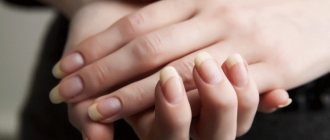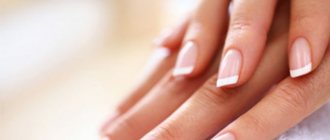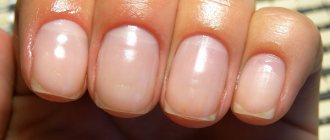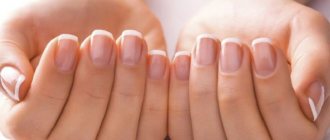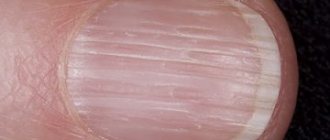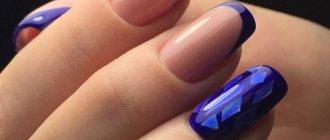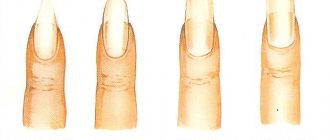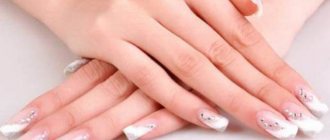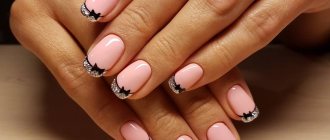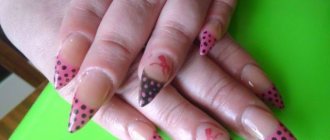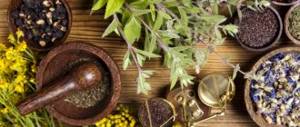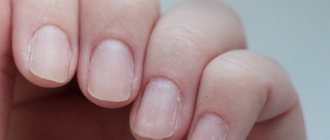Home page » Beauty » Nails
Author of the article
Svetlana Pavlikhina
Reading time: 7 minutes
AA
When your fingernails curl, it is not only unsightly, but also causes great discomfort. There can be many reasons for this condition. It is important to promptly find provoking factors and try to eliminate the problem. A healthy nail plate should be smooth and even, without ridges, chips, white spots, or cracks.
Features of the direction of bending the nail
Deformation can be in the form of:
- shape changes;
- bulges and depressions;
- bend in one direction;
- reducing the elasticity and structure of the plate;
- damage to the cuticle with the nail.
By the nature of the change, you can understand the reason that caused the development of the problem.
Bend your nails up
Nail plates usually bend upward when:
- unbalanced diet;
- lack of vitamins and minerals;
- plate injuries;
- lack of moisture;
- active use of aggressive detergents;
- damage by viruses and fungi.
Bend down
The twisting of the plate on the fingers downwards is often associated with hereditary characteristics. Artificial extension can help in this case.
In addition, the downward bend is associated with:
- finger injury;
- errors during extension.
- abuse of low-quality hand and nail care products, especially if they dry out the plates;
- exacerbation of chronic pathologies;
- lack of vitamins;
- diseases of the nail plate.
To prevent curling, do not wait until your nails grow too large. You need to systematically trim them carefully and select only high-quality and natural products for the care of nails, cuticles and hand skin.
Changes around the edges
Usually thin, soft and weak structures that lack nutrition are bent at the edges. The problem may also be associated with the slow growth of the plate, when it is exposed to the aggressive influence of provoking factors for a very long time.
Such a nail can bend from the side even with a slight impact on its surface.
Bend inward
Curvature of the plate with chaotic deformation is characteristic of a fungal infection. When the plate grows, it begins to twist inward and cut into soft tissue.
The problem can only be solved with the right treatment.
Deformation of long nail structures
Deformation of long nails is associated with a lack of fluid and vitamins. In this case, the tips can become thinner, break, become covered with small cracks, or peel off.
To normalize the condition, it is enough to review your diet, care products, and stabilize your water balance.
To restore nutrients, you can use massage, baths, compresses, and moisturizer.
Features of bending on different fingers
Due to heredity, the pathology most often appears on the index finger. This is due to the greatest workload of the phalanges when performing any actions.
The tip can also curl on a sore finger. If the deformity is caused by injury, then the bend is often diagnosed on any finger, depending on the affected area.
Deformation of nails after childbirth
During pregnancy, hormonal changes occur in the body, and the metabolic process changes. A lack of vitamins appears immediately on nails, hair, teeth, and skin.
Usually after childbirth the condition stabilizes completely or partially.
To speed up and alleviate a woman’s condition, it is necessary to eat properly, drink vitamins, use nourishing hand creams and oils
The structure of the nail plate on the hands and provoking factors for bending
The structure of the nail plate depends on many factors: the amount of calcium and trace elements in the human body, the presence of any diseases, as well as individual characteristics.
Curling the nail down is the process of deforming the nail . If the nail plate becomes too thin and soft, then its edges on the sides begin to slowly bend, growing into the side ridges of the cuticle.
The form of deformation can be completely different, but the most common is the bending of the nail downwards. This change in the shape of the nail gives the fingers an unattractive appearance that is difficult to disguise even with a good manicure.
Sometimes the bent end of the nail plate can lead to injury to the skin and damage to the nail itself. The disease also leads to problems in everyday life, as nails constantly cling to clothes and other objects.
Causes of curling nails
Changing the shape of the tips of the nails and twisting the plate occurs when they are exposed to external or internal factors.
External ones include:
- Incorrect care.
- Injury to the plate.
- Damage by fungi, bacteria.
Internal reasons include:
- Avitaminosis.
- Dehydration.
- The presence of chronic pathologies.
- Congenital features of plates.
- Weakening of the immune system.
- Metabolic disease.
In half of the cases, bending of nails occurs due to the penetration of a fungal infection.
Infections
Nails under the influence of pathogenic microorganisms can not only bend, but also change shape and color. In this case, it is not necessary that the fungus or infections strike the plates; the main thing is their development in the body.
Viruses are no less dangerous. They rapidly weaken the immune system, which immediately affects the structure of the plate.
To get rid of the problem, you need an integrated approach, since local treatment only temporarily reduces the symptoms of the disease.
Avitaminosis
If there is a metabolic disorder or an unbalanced diet, there is a lack of vitamins, which causes fragility, fragility, thinning, and splitting of nails.
The reason for the lack of vitamins may be internal pathologies that interfere with the absorption of nutrients. Severe diseases include anorexia, anemia, dystrophy, and dysbacteriosis.
To normalize the condition, it is necessary to treat existing ailments and periodically take a complex of vitamins A, B, C, D, microelements such as calcium, magnesium, iron, zinc and selenium are also important.
Diseases of the nail plates
Sometimes the question arises as to why problems with nails occur with proper nutrition and care. This may be associated with the development of some pathology.
The most common diseases include:
- Hippocratic nails.
- Koilonychia.
- Onychogryphosis.
- Platonychia.
- Micronychia.
- Ingrown nail.
Injuries
The nail may begin to curl after injury. With a strong impact, compression of the nail root or lunula, the plate is deformed, its proper growth and development is disrupted.
A modification of the structure triggers pathological processes, and in the future the nail can no longer grow normally, the problem remains forever. But with ordinary minor household injuries, the situation can be saved by cutting the plate at the point of thinning, taking vitamin complexes, medicinal lotions and baths.
Improper care
Improper care includes:
- Lack of hygiene.
- Frequent extensions.
- Working with household chemicals without gloves.
- Failure to comply with nail cutting rules.
Household chemicals and build-up quickly wear out the plates, making them thin and brittle. To prevent your nails from curling, you should take special medicinal baths and drink vitamin complexes.
Heredity
If the disease is inherited from ancestors, then it manifests itself in the bending of the plates when reaching a certain length. Even with sufficient thickness, the nail grows and curls into a tube . The thumbs and index fingers, and sometimes also the middle fingers, suffer from deviations at the gene level.
It is useless to treat such a pathology. Patients are advised to have nails of a certain length or have them extended.
Manicure for pecking nails
If a woman does not want to extend her nails, then a square or soft square shape will help smooth out the downward bending effect. But almond-shaped nails are in fashion today, and this shape is ideal only on straight nails.
Therefore, it is worth persuading the client to get her nails done, but using acrygel: a hybrid of gel and acrylic. To do this, you will need the acrygel itself (polygel), upper forms and preferably a special brush.
Durable but flexible acrygel is ideal for leveling the nail plate due to its thick consistency and will help “lift” the curling edges of the nails.
Use a high-quality rubber base, for example, Kodi Professional, and you will not only create perfectly smooth, straight nails of any length without a hint of an unaesthetic bend, but also maintain the health of the nail plate.
Other reasons
Sometimes deformation of the nail plate can be associated with hormonal changes, stress, and decreased immunity.
Problems are also observed with various diseases of internal organs.
Pathologies of the liver, gastrointestinal tract and pancreas cause disruption of metabolic processes and absorption of vitamins, and diabetes mellitus provokes the accumulation of sugar in the phalanges of the hands, which causes deformation and tissue necrosis.
Hereditary predisposition
Human health largely depends on heredity. Parents pass on to their children the peculiarities of their constitution and physique, hair and eye color. If your fingernails are bent downwards, it is recommended to pay attention to the hands of your father and mother. The deformed plates of the parents will indicate that it is a matter of genetics. Curves can be observed on all fingers at once or only on one.
It is impossible to change heredity, so it is useless to fight curved nails in this case. Moreover, the longer the length, the more noticeable the defect. You can hide it by trimming your nails until they begin to change shape. If length matters, you will need to use extensions.
Treatment
Sometimes you can straighten your nails by reviewing your lifestyle, normalizing your diet, sleep and rest patterns, and refusing extensions.
If the reasons lie in internal pathologies or infectious lesions, then you should resort to drug treatment, choose a diet and take vitamins in courses.
Various baths, massages, paraffin therapy, and hardware correction are also useful. In severe cases, leveling is carried out with special plates and staples. Removal of the nail is necessary if the structure is completely damaged by the fungus.
Medications
Medicines are selected individually, taking into account the cause of the pathology.
May be assigned:
- Antifungal agents. They destroy pathogenic flora and restore the integrity of the plate. Ketoconazole, Clotrimazole, Mycozan, Fluconazole are popular.
- Antibiotics. Indicated when a bacterial infection occurs. Often used: Clindamycin, Levomycetin, Erythromycin.
- Vitamin complexes: Vivasan, Merz.
ethnoscience
Strengthening your nails can also be done at home.
For this use:
- Lemon masks. Nails are immersed in lemon pulp for 5-10 minutes.
- Vitamin baths. Add 2 drops of iodine and vitamin A into the prepared container with water. Keep the plates in the solution for about 15 minutes. After the procedure, your fingers should be dry for several hours so as not to wash off the nutritional layer.
- Oil baths. Add a few drops of grape seed essential oil and 5-10 ml of olive oil to green tea. The procedure is done within 10 minutes.
- Baths with sea salt. You can keep your hands in the solution for up to 20 minutes.
Treatment methods: what to do to fix it?
Read on to learn how to cure a nail plate that grows downward.
First, you need to consult a doctor specializing in this problem - a dermatologist - to conduct an examination and identify the correct cause that causes the nail plate to bend down.
If in your case the cause is improper nail care, then avoid visiting beauty salons and manicures. It is better to apply special restorative varnishes to the upper layers of the nail plate, which contain substances that are beneficial for nails.
When the nail grows, carefully trim it short , completely cutting off the damaged part.
When fungal diseases are detected, it is necessary to use specialized ointments and creams prescribed by the attending physician. The average course of such treatment is two weeks. In addition, it is necessary to take a vitamin complex to restore the lack of necessary components in the body.
There are also several popular traditional medicine methods that are excellent in combating nail plate deformation. These include various baths and nail masks.
Let's look at a few popular recipes:
- Wax based mask .
It is necessary to melt thirty grams of beeswax. Next, the product is mixed with one teaspoon of any moisturizing cosmetic oil (for example, orange, almond seed, coconut, burdock, peach seed, cedar, and so on). Then add five drops of essential oil (for example, tea tree, grapefruit, wheat germ, mint, lavender, etc.) to the resulting mixture. Fingers must be dipped into the mask, then placed in a container with cold water until the wax completely hardens. The product must be kept on the nails for twenty minutes. You can make a mask twice a week. - Mask based on red pepper .
An excellent product that stimulates blood flow, which improves the growth of the nail plate and makes its structure stronger. Add a spoonful of baby cream, two teaspoons of red pepper to three tablespoons of boiling water and mix the resulting mixture thoroughly. Then apply the mask onto your fingers in a thick layer after it has cooled. Leave the product on your nails for half an hour, then wash off your hands with warm water and soap. This mask can be used maximum once every two weeks. - Bath for restoring the nail plate . Pour 200 milliliters of warm water into a container, add two tablespoons of iodine and one spoon of aloe juice, a little baking soda. Dip your fingers in the resulting liquid for fifteen minutes, then wipe them with a towel until completely dry. After the procedure, you can apply a rich cream or cosmetic oil to the cuticle to avoid dryness.
A good way is to massage the phalanx of the finger. Thanks to this, the blood flow in the nail plate area increases, the blood is saturated with oxygen, and the necessary vitamins and minerals are better absorbed into the layers of the skin.
Take the cream, apply it to the area of your finger for massage and with a special brush or the fingers of your other hand, perform massage movements for one minute. You can repeat the procedure two to three times a week.
Prevention measures
To minimize the risk of developing a bend in the nail plate, the following rules must be followed:
- Use protective equipment when working with aggressive chemicals.
- Refuse to have nail extensions done or have them done only by a qualified professional.
- Normalize your diet by enriching your diet with greens and healthy foods.
- Learn how to cut your nails correctly.
- Promptly treat all inflammatory processes of the stratum corneum and chronic pathologies.
How to treat curled nails
There is no consensus on which treatment for curled nails is most appropriate. It depends on the severity of the condition, comorbidities, and the person's preferences and expectations. If you notice the first stages of ingrown toenails , take it seriously and do not let the situation worsen, because the problem is much easier to solve in the early stages. First, wet your fingers and massage the skin around the problem nail. If the area is inflamed, be sure to wash it with an antiseptic solution. Next, clean the bottom of the nail, making sure to find the edge. Make sure the tip is smooth and file the nail straight across. Do not round the edges, as this will only increase the likelihood of the nail growing into the skin in the future. If your toenails curl, choose spacious, properly sized shoes.
I hope my information was useful to you. Be healthy and beautiful!
Ingrown nail
This condition is typical for inflammatory and infectious pathologies of the finger. The nail can bend and pierce the skin if it is not properly cared for or if the nail trimming technique is not correct. Fungal infection or injury cannot be ruled out.
To get rid of the problem, you need to wear comfortable shoes, trim your nails carefully, and treat the fungus in a timely manner.
If the nail is deeply ingrown, then take baths with soda or herbal antibacterial mixtures.
After steaming, carefully separate the skin from the side and cut off the bent piece of the plate. If there is pus, it is necessary to relieve inflammation with Vishnevsky ointment, Levomekol.
If independent extraction is not possible, then local surgery is prescribed.
Expert advice
Well-groomed nails are of great importance to every woman. It is difficult to disguise a deformed plate, since the hands are always visible. No woman wants to come to terms with the fact that her nails curl down. A dermatologist knows what to do in this situation.
The doctor will prescribe the necessary diagnostics to determine what exactly led to the development of the defect. If it turns out that curvature of the nails is only a symptom of some disease, he will prescribe its treatment. After the pathology is defeated, the plate will gradually return to its original shape.
If no serious pathologies are identified, the specialist will help correct some points that will help bring the appearance of the nail in order. This includes:
- taking vitamin-mineral complexes containing vitamins B12, D3 and iron;
- enriching the daily diet with foods such as fish, cheese and spinach;
- constant monitoring of protein levels in the body (for some people, even a minimal deficiency of this component causes a decline in immunity and deterioration in the condition of hair and nails);
- daily massaging the cuticle before bed and rubbing various oils into it, for example, olive;
- complete refusal to use nail polish removers with acetone;
- constant protection of hands and nails with rubber gloves while washing dishes;
- predominant use of ceramic or glass files;
- You can trust your nails only to highly qualified manicurists;
- use of orthopedic shoes.
